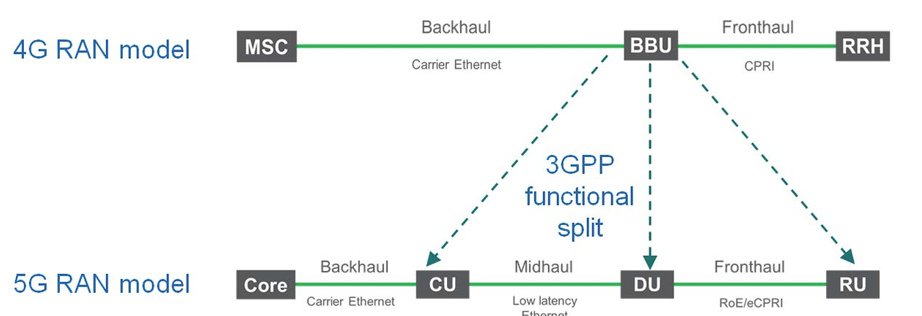First, we need to understand the definition of Fronthaul. Fronthaul is the transmission connection between the Radio Frequency (RF) module and the baseband processing Unit (BBU) in the mobile wireless network.
In the traditional distributed RAN or D-RAN, the fronthaul distance is short as the RF module and BBU are directly connected via optical fibers. However due to network evolution, data rate growth, and the need for flexibility plus a decrease the cost, BBUs need to be deployed in a more flexible and centralized manner while RF modules can be deployed remotely. For that reason, D-RAN is no longer the optimum option in some scenarios.
Unlike the 4G, 5G introduced the RAN disaggregation where the BBU can be disaggregated into Distributed Unit (DU) and Centralized Unit (CU) and can be deployed far apart from the Radio Unit (RU) but with some constraints related to the fronthaul throughput and latency requirement.

D-RAN and C-RAN in 5G Era
5G provides many new technologies and features like new spectrum bands 3.5GHz and mmWave, massive MIMO and Beamforming, ..etc. All of the new features impact the network site design. As an example, the higher the frequency, the shorter the coverage distance and this will lead to the need for a site density increase. Here C-RAN can solve such problems as site acquisition space, high rental, and high power consumption, and hence TCO reduction.
Note: C-RAN is lower than D-RAN but not for all cases like achieving the fronthaul throughput and latency requirements.
Fronthaul bandwidth & Latency requirement Challenges using Microwave
As per Huawei’s typical configurations, the microwave fronthaul bandwidth requirements vary based on the environment.

- Urban Areas: required bandwidth is a key challenge as for TDD-band deployment requires a bandwidth between 50-200 Gbps, calling for D-Band. D-band refers to the frequency range from 130 to 175 GHz.

- Suburban Areas: the main challenge is the CPRI or Common Public Radio Interface conversion, It’s highly recommended to read this article to understand why we need to go for eCPRI instead of CPRI in 5G. Also, CPRI bandwidth compression is needed to compress the bandwidth between 10 Gbps to 20 Gbps for E-Band transmission.
- Rural areas, characterized by long distances, traditional microwave frequency bands, CPRI bandwidth compression, and interface conversion, are also necessary.
What about Fronthaul latency?
Regarding the Latency, In a 4G network, the main application scenario for microwave is still backhaul which provides millisecond-level latency. 5G will require bigger capacity and lower latency. The 5G midhaul and backhaul require latency ranging from 100 us to several ms, while the 5G fronthaul requires latency of less than 50 us. Conventional microwave equipment makes it difficult to meet the much stricter capacity and latency requirement for fronthaul.
High-frequency microwave equipment offers larger capacity and greater bandwidth, thus greatly reducing transmission latency. Take an E-band device as an example. When using 2 GHz bandwidth and 128 QAM, it can deliver 10 Gbps throughput per link with less than 20 us latency. This meets the low-latency requirements of 5G fronthaul.
E-Band Microwave Frequency Band
E-band (71–76 GHz and 81–86 GHz) used for FDD mode is a pair of 5 GHz channels. It offers a bandwidth of 62.5 MHz to 2 GHz and delivers up to 10 Gbps throughput at 128 QAM. In a 4G network, the E-band can be used alone for short-distance large-capacity backhaul and CPRI fronthaul or with the traditional bands to support large-capacity, long-distance, and multi-band backhaul. With the move to 5G, fronthaul and midhaul applications will gradually increase.
Fronthaul connections will need to scale up to 30 Gbps with latency requirements lower than 30 us. E-band featuring large capacity and low latency is preferred for such a scenario. The 5G mid-haul and backhaul will still mainly use the multiband approach to provide 10 Gbps to 25 Gbps capacity while meeting the latency requirements of 100 us.
